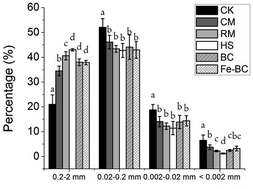Alleviation of cadmium phytotoxicity to wheat is associated with Cd re-distribution in soil aggregates as affected by amendments
Abstract
Soil aggregates exert a significant influence on the retention and bioavailability of Cd in soil. This study investigated how applications of various soil amendments affected soil aggregation and Cd phytotoxicity. A staple crop, wheat (Triticum spp.), was grown in Cd-polluted soil amended with either clay mineral (CM), rock mineral (RM), humic substances (HS), biochar (BC) or iron-based biochar (Fe-BC). Results indicate that addition of soil amendments promoted the formation of large soil aggregates (0.2–2 mm and 0.02–0.2 mm) with greater mass loading of Cd (total Cd or DTPA-extractable Cd). Moreover, significant negative correlations between the mass loading of Cd in large aggregates and Cd accumulation in wheat tissues were observed. The effectiveness in mitigating Cd phytotoxicity was dependent on the type of amendment applied. Among them, addition of HS was most effective with the highest total Cd accumulation observed in the soil fraction of 0.2–2 mm (138.1% of the control) and lowest Cd concentration observed in wheat grain (56.9% of the control). The results suggest that the re-distribution of Cd among soil aggregates was the likely factor that controlled the quantity of plant available Cd in the soil-plant system.



 Please wait while we load your content...
Please wait while we load your content...